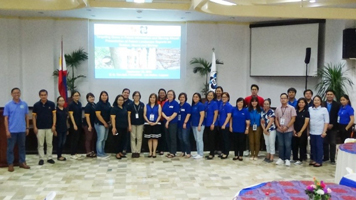 As a way to intensify the management of its Intellectual Properties, the Philippine Council for Agriculture, Aquatic and Natural Resources Research and Development of the Department of Science and Technology (DOST-PCAARRD), in partnership with the Intellectual Property Office of the Philippines (IPOPHL), is conducting a project.
As a way to intensify the management of its Intellectual Properties, the Philippine Council for Agriculture, Aquatic and Natural Resources Research and Development of the Department of Science and Technology (DOST-PCAARRD), in partnership with the Intellectual Property Office of the Philippines (IPOPHL), is conducting a project.
Titled, “Enhancing PCAARRD’s Intellectual Property Management through Prior Art Search and Patent Landscape Assessment,” the project aims to develop strategies to strengthen the agriculture, aquatic and natural resources (AANR) research priorities in commodities such as milkfish, mango, goat, crab, shrimp, banana, rice, abaca, swine bamboo, rubber and feed resources.
A total of 150 Prior Art Search reports on the PCAARRD-generated technologies and 12 Patent Landscape Reports (PLRs) are the targets of the two-year project.
Prior art search is done to determine and craft intellectual property management plans for the ongoing PCAARRD projects. PLRs, on the other hand, will serve as reference of the agency in developing research and development (R&D) programs for funding.
To date, IPOPHL has prepared 75 prior arts search reports, while six PLRs on priority R&D commodities of mango, goat, milkfish, bamboo, banana, and swine were presented during the 1st and 2nd Landscape Report held last July 2017 and January 2018. The data were gathered by the IP Search and Documentation Division of IPOPHL’s Documentation, Information and Technology Transfer Bureau.
Three additional PLRs on rubber, abaca, and shrimp were presented during the 3rd PLR Presentation held at the PCAARRD headquarters. According to IPOPHL, as of 2017, there are 43 patent family fillings for abaca technologies; 42 for rubber technologies; and 16 for shrimp technologies in the Philippines. Although patent filings on the said commodities have an increasing trend, it is evident that these figures are very low compared to other countries like China and United States of America, which have the most number of patents filed on the said commodities.
IPOPHL emphasized that through prior art search and PLRs, the agency can assist PCAARRD on which commodities or fields of research are congested with R&D activities and which are open and waiting for potential R&D programs. The patent information from these PLRs and prior art search reports will serve as the Council’s guide to assess the novelty and value of projects being proposed for potential funding as well as avoid research duplication. These data are deemed important to maximize funds for research initiatives in the AANR sectors.
Improving the lives of the Filipino by providing technologies is mandated by the Republic Act 10055 or the Technology Transfer Act of 2009. This provided an additional mandate to PCAARRD to monitor research efforts of state universities and colleges (SUCs) and research and development institutes (RDIs). The provision also tasked the Council to monitor the said institutions in terms of securing intellectual property protection and pursuing technology commercialization.
